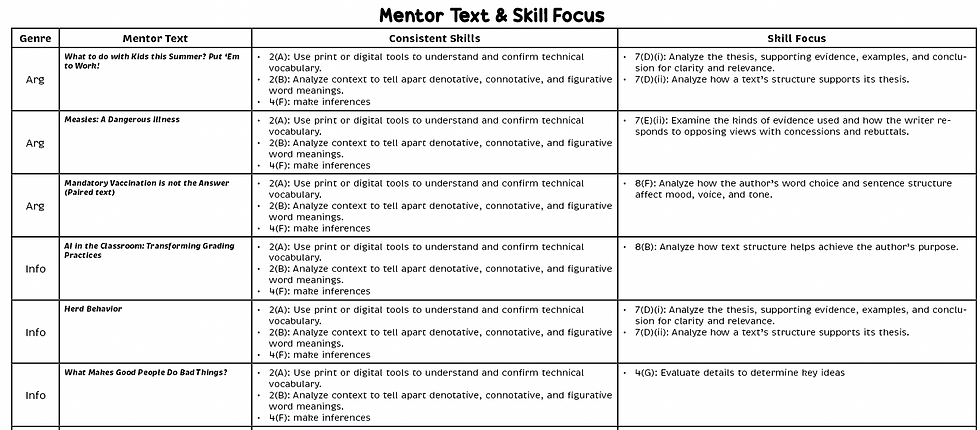How to Build a Year Long Curriculum
- Sarah Curtis
- Jul 13
- 3 min read
If you've ever wanted to stop stressing every Sunday and start planning your year, this is it!
🗓️ Know Your School Calendar
Why does this help? Because you need to know—before you start a text—how much actual time you have in class to finish it.

I learned the hard way that a four-day school break right in the middle of a reading and writing unit is a disaster. My students come back like, “Wait, we read something?” and I’m thinking, Yes, yes you did—and we discussed it for three days!
It’s not that they’re lazy. It’s that they genuinely forget what we were doing. Then they spend twenty minutes just trying to remember what the text was about before they can even begin writing. That’s a huge waste of time. Having a year-at-a-glance calendar solves this. You don’t have to plan every detail, but sketch out a rough framework of what texts and skills you’ll cover each week. That way, you’ll avoid placing a key text during a week with half-days or random assemblies, and you’ll maximize the time you have to actually teach.
🤔 Know What Skills Fit With Your Content

I like to center each lesson around a specific skill—it keeps my questioning focused and helps me design quizzes that actually align with what we’re working on.
To make this easier, I start with a list of my TEKS (Texas’ English II standards), and I map them onto the texts I want to teach. I ask myself: Which skill naturally fits with this story, article, or poem? If a standard feels like a better match for another text, I move things around.
Sometimes I start with the standards and choose texts to match. Other times, I already know what I want to teach, so I adjust the skills accordingly. Either way, I make sure every TEKS gets a home—and I track it by sorting them into columns so I can clearly see which ones I’ve covered.
🔐 Lock Down the Skills That Build on Each Other & Choose What to Teach Explicitly
English II has a ton of individual skills—some of which build on each other, and some that feel like they came out of nowhere. I know I won’t have time to teach everything from my revising and editing list, so I decide early on which ones are essential and which ones I can combine or spiral in later.

This is where my calendar comes in handy. I use it to:
Prioritize must-teach skills (like theme or text structure)
Decide which standards need explicit instruction in reading vs. writing
Cut anything that doesn’t fit the time I actually have
I already know my students struggle with theme, so I plan time early in the semester to break it down—before we dive into fiction. By laying out everything week by week, I can see where to shift things around and make sure they’re prepared before semester exams.also use it to make sure they have what they need before semester exams.
👷♂️ Start Building Your Lessons & Keep It Consistent
I keep my ELA lessons structured mostly the same each week. It helps me stay focused and helps students recognize patterns, even when we switch genres.
Here’s what a typical week looks like:
Day 1
Pre-reading & vocabulary
Read & annotate
Genre-specific “Thinking Jobs” (what I use here)
Comprehension quiz
Day 2
Class discussion (great for review)
Short constructed response questions
Analysis quiz
Days 3 & 4
Brainstorm & write essays
I pull struggling students 1:1 while others are writing
Day 5
Revising & editing lesson of the weekSometimes I move this to Monday if I know attendance will be low. I can reteach anything quickly during Spiral Review anyway.
Other Things I Did:
Homework is whatever skill I taught the previous week or what wasn't finished in class.
Warmups are either practice with a new skill, or review for a previously taught skill on the Friday or Monday.
I include sentence stems & frames for almost everything and translate my materials ahead of time into Spanish for my newcomers so they can immediately participate.
I planned spiral reviews of revising and editing skills to reinforce what was taught and make them remember it!
Final Thoughts: Plan Smart, Teach Smarter
You don’t need to have every single lesson planned out in July—but having a clear roadmap will save you so much stress during the school year. Knowing what skills you're teaching, when you're teaching them, and how they build on one another makes your day-to-day planning faster and more focused.
Plus, your students benefit when the structure stays consistent and the expectations are clear. They’re more likely to engage with the content (and actually remember it) when the routine feels familiar.
Build your calendar. Match your texts and skills. Choose what matters most. Then let the details fall into place. ✨You’ve got this.✨





